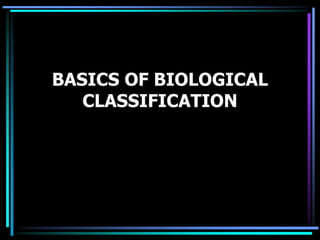
BASICS OF BIOLOGICAL CLASSIFICATION
- 1. BASICS OF BIOLOGICAL CLASSIFICATION
- 4. Autotrophs capture the light energy from sunlight and convert it to chemical energy they use for food. Heterotrophs must get energy by eating autotrophs or other heterotrophs. Decomposers, aka saprobes, are heterotrophs that recycle dead organisms by breaking them down.
- 6. •Phylogeny •Classification •Order •Systematics •Taxonomy •Family Hypothesis •Aristotle •Genus •Cladistics •Linnaeus •Species •Derived •Kingdom •Common name character •Phylum •Scientific •Cladogram •Class name •Dichotomous •Binomial Key nomenclature
- 7. • Taxonomy is the science of grouping and naming organisms. • Classification the grouping of information or objects based on similarities.
- 8. •We only know about a fraction of the organisms that exist or have existed on Earth. •Taxonomists give a unique scientific name to each species they know about whether it’s alive today or extinct. • The scientific name comes from one of two “dead” languages – Latin or ancient Greek. Why use a dead language?
- 9. Devil Cat
- 10. Ghost Cat
- 11. Mountain Lion
- 12. Screaming Cat
- 13. Puma
- 14. Florida Panther
- 15. Cougar
- 16. •There are at least 50 common names for the animal shown on the previous 7 slides. •Common names vary according to region. •Soooo……why use a scientific name?
- 17. Binomial Nomenclature •a two name system for writing scientific names. •The genus name is written first (always Capitalized). •The species name is written second (never capitalized). •Both words are italicized if typed or underlined if hand written. Example: Felis concolor or F. concolor Which is the genus? The species?
- 18. "Formal" scientific names should have a third part, the authority. The authority is not italicized or underlined. The authority is written as an abbreviation of the last name of the person responsible for naming the organism. Since Carolus Linnaeus was the first person to name many plants, the L. for Linnaeus is very common in plant scientific names. An example is Quercus alba L.
- 19. Phylogeny, the evolutionary history of an organism, is the cornerstone of a branch of biology called systematic taxonomy. Systematics, as systematic taxonomy is commonly called, is the study of the evolution of biological diversity.
- 20. A phylogenetic tree is a family tree that shows a hypothesis about the evolutionary relationships thought to exist among groups of organisms. It does not show the actual evolutionary history of organisms. Why a hypothesis?
- 22. Phylogenetic trees are usually based on a combination of these lines of evidence: Fossil record Morphology Embryological patterns of development Chromosomes and DNA
- 23. Fossil
- 24. Morphology
- 25. Homologous Structures
- 26. modifies homologous structures Adaptive Radiation - Modifies homologous structures
- 28. Convergent Evolution These animals have evolved similar adaptations for obtaining food because they occupy similar niches. What can you infer about their phylogeny from their geographic locations?
- 29. Convergent evolution leads to………. Analogous Structures - •Traits that are morphologically and functionally similar even though there is no common ancestor.
- 33. Embryology
- 34. Cladistics - is a relatively new system of phylogenetics classification that uses shared derived characters to establish evolutionary relationships. A derived character is a feature that apparently evolved only within the group under consideration.
- 35. DNA
- 36. There are three basic assumptions in cladistics: 1.Organisms within a group are descended from a common ancestor. 2.There is a bifurcating pattern of cladogenesis. 3.Change in characteristics occurs in lineages over time.
- 37. A phylogenetic tree based on a cladistic analysis is called a cladogram. What derived character is shared by all the animals on the cladogram on the next slide?
- 39. The acacia and its ants are an example of coevolution. Each influences the others evolution. Can you think of any other examples of coevolution?
- 40. Punctuated Equilibrium “instead of a slow, continuous movement, evolution tends to be characterized by long periods of virtual standstill ("equilibrium"), "punctuated" by episodes of very fast development of new forms” The "punctuated equilibrium" theory of Niles Eldredge and Stephen Jay Gould was proposed as a criticism of the traditional Darwinian theory of evolution…what is it called?
- 41. The Dichotomous Key • A key is a device for easily and quickly identifying an unknown organism. • The dichotomous key is the most widely used type in biological sciences. • The user is presented with a sequence of choices between two statements, couplets, based on characteristics of the organism. By always making the correct choice, the name of the organism will be revealed.
- 43. A. one pair of wings 1. B. Two pairs of wings
- 44. • Domain Archaea – Includes newly discovered cell types The Three Domains – Contains 1 kingdom – the Archaebacteria •Domain Bacteria – Includes other members of old kingdom Monera – Has 1 kingdom – the Eubacteria •Domain Eukarya – Includes all kingdoms composed of organisms made up of eukaryotic cells – Protista – Fungi – Animalia – Plantae
- 45. The major classification levels, from most general to most specific (several of these have subdivisions) A group at any level is a taxon.
- 46. Categories within Kingdoms Kingdoms are divided into groups called phyla Phyla are subdivided into classes Classes are subdivided into orders Orders are subdivided into families Families are divided into genera Genera contain closely related species Species is unique
